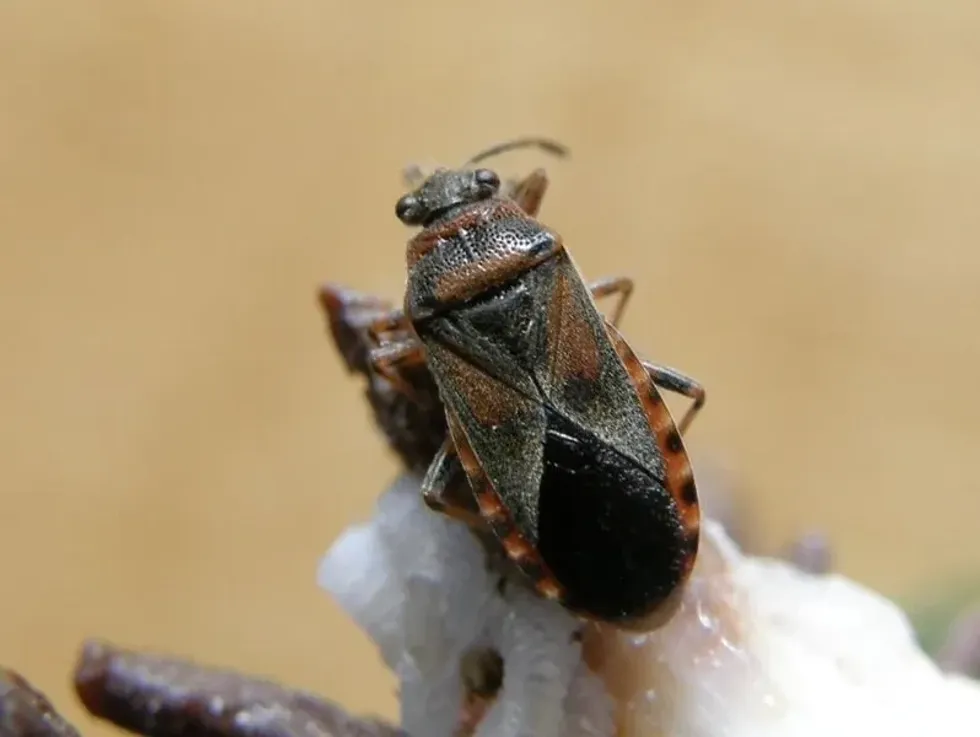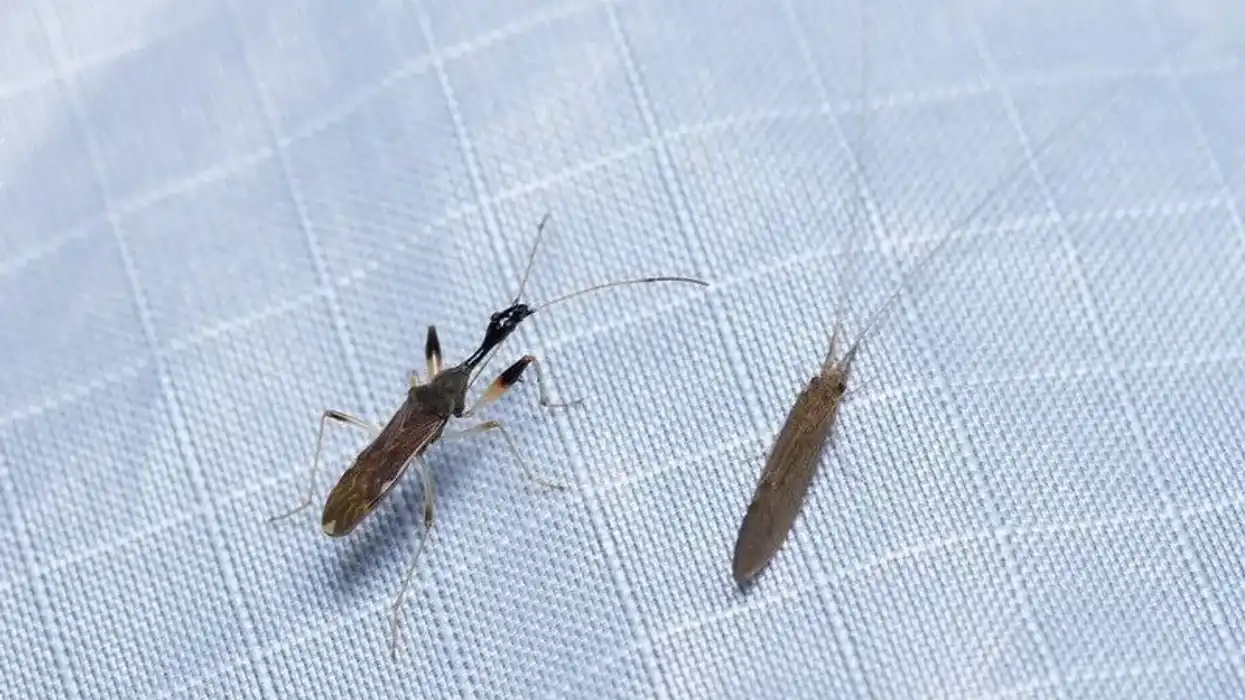Are you looking for interesting facts about the Arocatus melanocephalus, also known as the elm seed bug?
Whether you want to know about the elm seed bug diet, where you can find them, what they feed on or how to get rid of these nuisance pests, read on to find the answers to your burning questions!
As well as giving you ways of identifying elm seed bugs, we suggest a range of ways you could manage an elm seed bug infestation such as pest proofing buildings, weather stripping structures, doors and windows, and using elm seed bug repellent.
The key is to have sealed all the cracks and crevices through which the pest might be entering.
Although they can be a nuisance, elm seed bugs are also fascinating insects to study. They reproduce very quickly and the elm seed bug nymph goes through many stages before growing into a fully-fledged adult.
They are good insects to build children's school projects on, as long as no one gets too close! While the pest doesn't bite humans, it releases a disagreeable odor when it feels it is in danger so stay well away and do not bring them indoors!
If you're after more interesting information about other types of insects, why not take a look at these ambush bug and giant water bug facts too?
Elm Seed Bug Interesting Facts
What type of animal is an elm seed bug?
An elm seed bug is an insect.
What class of animal does an elm seed bug belong to?
An elm seed, as its name indicates, is a bug from the Insecta class.
How many elm seed bugs are there in the world?
Although it is not known precisely how many elm seed bugs currently live in the world, it is probably in the range of millions. They are an invasive species that reproduce very quickly and their number is increasing.
Where does an elm seed bug live?
Elm seed bugs can be found in the woods, on a farm, or even in a house.
What is an elm seed bug's habitat?
Elm seed bugs tend to live in temperate forests and woodlands. They particularly enjoy living on elms, sycamores, poplars, oaks, and alders.
Who do elm seed bugs live with?
Elm seed bugs tend to live in large groups.
How long does an elm seed bug live?
An elm bug seed can live for about one year. It grows from larvae to a nymph to an adult very quickly, in the space of a month or two.
How do they reproduce?
Elm seed bugs are oviparous, meaning they reproduce by laying eggs. In spring, the bugs move to trees and egg-laying begins when the elm flowers start to bloom.
The elm seed bug life cycle is very fast and occurs over less than a year. The eggs hatch in spring and summer, from May to June, and the larvae progress from a nymph to a fully-fledged adult elm seed bug in five stages.
What is their conservation status?
There is no concern regarding their conservation status. In fact, the number of elm seed bugs around the world is growing and recent infestations have been recorded in Utah, for example. They are classified as Least Concern.
Elm Seed Bug Fun Facts
What do elm seed bugs look like?
Elm seed bugs are dark red with a black triangular shape on their backs and a red belly. They have wings tucked under their backs.
Half of their wings are a black membrane, while the other half are red and leathery. Their wings are dotted with white, red, and black dots. Younger elm seed bugs are smaller and brighter red in color.
How cute are they?
Elm seed bugs are not traditionally considered cute as they are highly invasive. In fact, they are classed as a pest, a creature which humans tend to get rid of.
How do they communicate?
Although it is not known precisely how elm seed bugs communicate, when they are in danger they emit a terrible smell which indicates their fear and aims to deter predators.
How big is an elm seed bug?
An adult elm seed bug is approximately 0.3 in (0.85 cm) long, about 18 times smaller than an average mouse.
How fast can elm seed bugs move?
Although it is hard to estimate how quickly an elm seed bug can move, they can scuttle around rapidly as they are small insects.
How much does an elm seed bug weigh?
An elm seed bug is a tiny insect, so it weighs less than 0.04 oz (1 g)!
What are their male and female names of the species?
There isn't a specific name for a male or female elm seed bug.
What would you call a baby elm seed bug?
There is no specific name for a baby elm seed bug, their names depend on the stage of development they are at and range from nymph to larvae.
What do they eat?
Elm seed bugs, as their name suggests, mostly eat the seeds of elm trees and other debris produced by elm trees. They have been known to eat elm seeds from different species including the Siberian elm.
Are they harmful?
The elm seed bug emits a strong unpleasant scent when crushed or touched, but it is not a threat to human health. It is a nuisance as it can infest whole buildings very quickly. This nuisance pest can be harmful to trees, plants, and wooden structures, but not to humans.
Would they make a good pet?
No. Adult elm seed bugs emit a very unpleasant odor when they feel they are in danger (for example when they are touched) and they are a nuisance pest that can reproduce very quickly, leading to infestations.
Did you know...
Elm seed bugs are originally from Europe, but they have since been introduced into North America and Asia.
Elm seed bug infestations are more likely to occur in the late summer and in the fall. This is thought to be because the insects enter buildings to escape from the heat.
Recent elm seed bug infestations have been recorded in Utah, Colorado, and Idaho, amongst others.
The elm seed bug's scent glands are located on their thorax, in other words on their chest area.
Does the elm seed bug bite?
Adult elm seed bugs do not bite, and they do not carry infectious diseases which can be passed on to humans.
How to get rid of elm seed bugs?
Although it is a major nuisance, there are various ways you can control an infestation of elm seed bugs. In order to keep elm seed bugs out of your house, you can try pest-proofing it.
Weather-strip your doors and windows as firmly as possible using door sweeps, screens door sweeps, screens, sealants, or even tape.
Any other cracks and crevices in the building should be sealed, even plumbing, vents, and electrical conduits. The key is that there should be no windows, vents, or cracks through which the pest can enter!
If you see the pests indoors, you can vacuum them and dispose of the bag, making sure it is well sealed. You can also vacuum using a wet-dry vacuum with a small amount of water and dish soap to drown the bugs.
Do not attempt to get rid of them by crushing them as they emit an unpleasant smell when they are crushed.
If there are elm trees around the buildings impacted, you should clean up their litter and toppled elm seeds, especially in the spring and fall, as these elm seeds are the elm seed bugs' main diet. In the event of a widespread infestation, you might even want to consider removing the elm trees altogether.
If none of these solutions are enough to save the buildings and structures infested with these pests, you could try using an elm seed bug insecticide or an elm seed bug trap indoors to control the infestation.
Here at Kidadl, we have carefully created lots of interesting family-friendly animal facts for everyone to discover! Learn more about some other insects including the wheel bug, or the stick bug.
You can even occupy yourself at home by drawing one on our realistic bug coloring pages.










